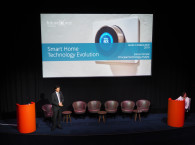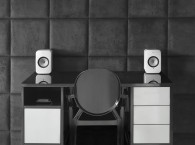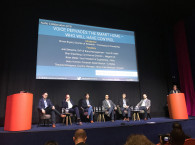As some of our social media followers on Twitter have noticed (a not so subtle hint for those that still don't follow audioXpress and Voice Coil on Twitter and Facebook...), on November 9, 2017, I attended the Futuresource Audio Collaborative 2017 conference, at the Ham Yard Hotel in London. With the topic "A Change is Gonna Come," the conference was a valuable and insightful event. The audio recording of the full extent of these presentations has been uploaded to Youtube.
To entice our readers to actually spend the hours listening to those interventions (and for those who don't have the time to do it), I will share some of the key highlights, adding some personal takes on the topics addressed.

I have immensely enjoyed the opportunity to attend the event and exchange views not only with Futuresource's market analysts, but also to speak personally with many of the speakers and attendees. Panels included some of the leading executives and experts in diverse fields of the audio and music industry, addressing the multiple verticals, such as Audio's Role in the Smart Home; Immersive Audio Experiences; The Expanding Influence of Social Media Platforms; and The World of Luxury Audio. The complete list of speakers and panels is available here.
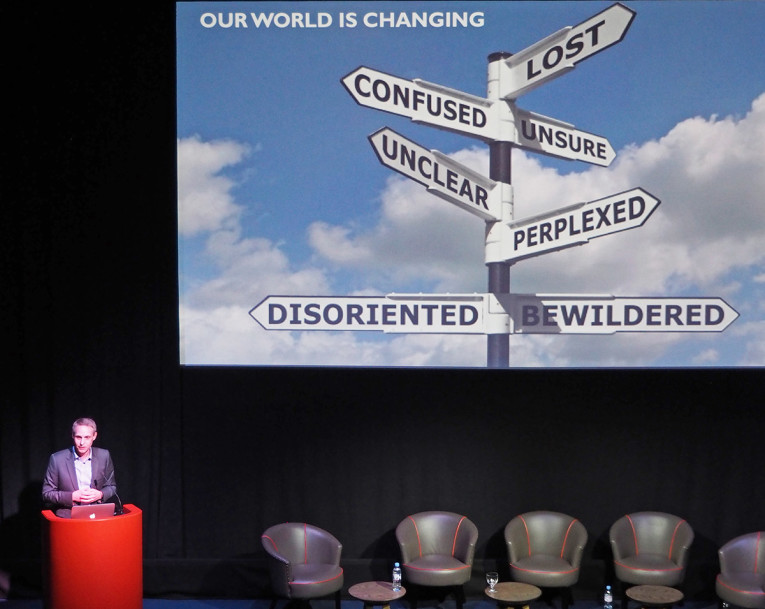
The event opened with a keynote by Adriaan Thierry, Managing Director, EMEA & AMPAC, Sonos, who provided an insightful vision of how this leading company foresees its space in the industry and is committed to its vision to offer the best possible solutions for whole home audio. In a way, it was refreshing to hear how the pioneers of multiroom have not lost focus, and are so committed to evolving in this segment and see a huge potential on the category, even if facing the challenges of voice integration and the smart speaker's disruption, by building those additional features on their own connected platform and technology and still lead on the home audio space. In fact, as Adriaan Thierry stated, Sonos sees a huge opportunity to lead in the "golden age of content, open and immersive," by leveraging its 15 years of leadership in home audio "to architect the ultimate sound experience for the home."
There was also a market presentation of Futuresource's most recent report on Market & Tech Trends in Headphones and Distribution, which audioXpress has previously discussed here, and here. I will still highlight two key takeaways from the presentation by Zlata Jelisejeva, the author of the research. First the characterization of the use-cases for headphones, indicating a huge growth potential in voice personals assistants, translation services, and hearing enhancements. Secondly, the tremendous evolution of the true wireless category, which has grown 2680% from Q3 2016 to Q3 2017, since Apple introduced the tremendously successful AirPods.
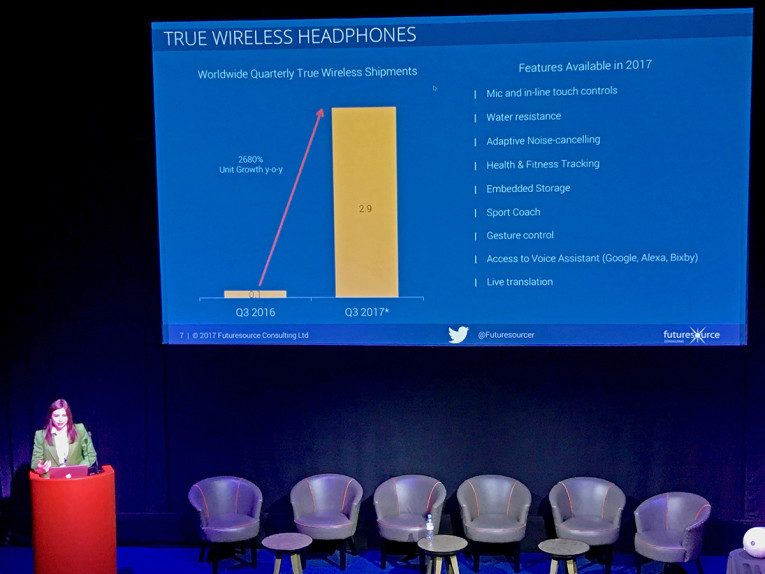
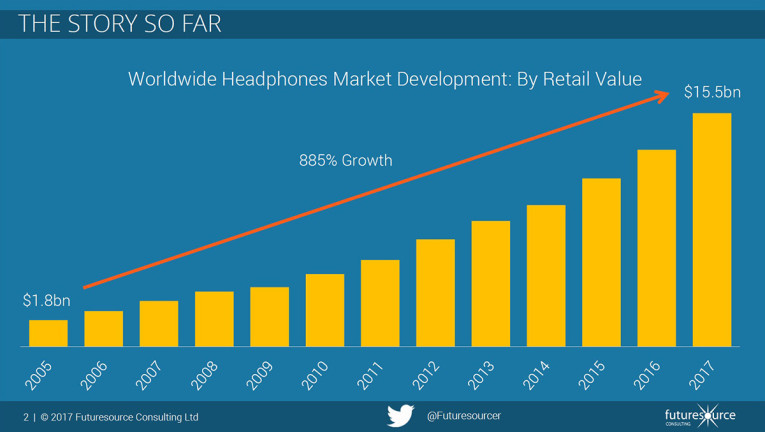
The event in itself was a key networking opportunity for many of the leading experts in some of the most important companies and brands in the market today to freely engage in inspiring conversations and exploring partnerships - which as it was demonstrated multiple times in the presentations, are key to the industry's momentum. This included an interesting presentation by Andrew Tiil, VP Technology and Marketing, Harman, on "The Rate of Change of In-Car Entertainment," and a closing keynote by Riad Hawa, VP Global Hardware and Partnerships, Deezer on "What's Next for Music Streaming."
During one of the panels, "The World of Luxury Audio", Bob Stuart, creator and MQA and Meridian's founder, stated: "whenever the music industry did well, the hardware industry did well," referring to the fact that, over the last decades, the music industry has flourished with recording and distribution formats - from vinyl to CDs and digital streaming, while suffering severe downturns with the audio cassette, mp3 and digital piracy. As Bob Stuart maintains, there is a direct relationship between the quality of the formats that are available to the consumer and the way consumers respond by investing in better sound reproduction to enjoy that music.
My key takeaway from that statement is that the audio industry in general is now thriving and faces very exciting perspectives. As Bob Stuart, and most of the other speakers and panelist in this event confirmed, the market is growing - even if companies and consumers are confronted with disruption, changes, confusion, and uncertainty, as Sonos' Adriaan Thierry remarked. I think that summed up this event well.
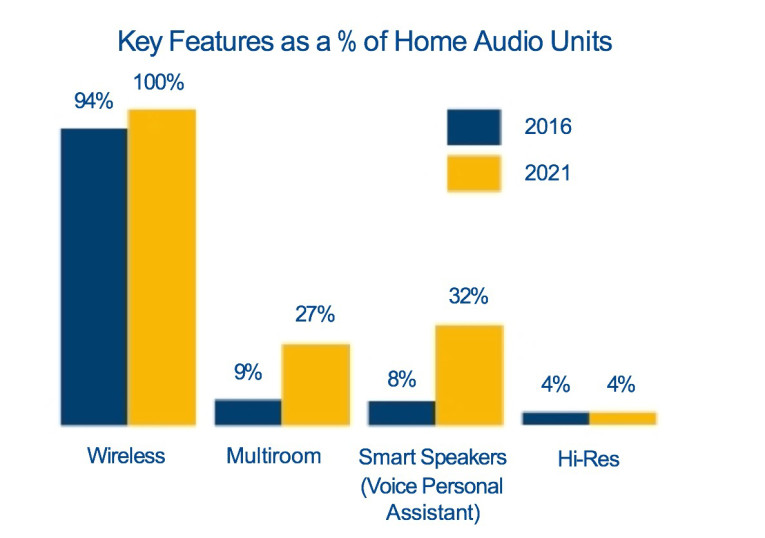
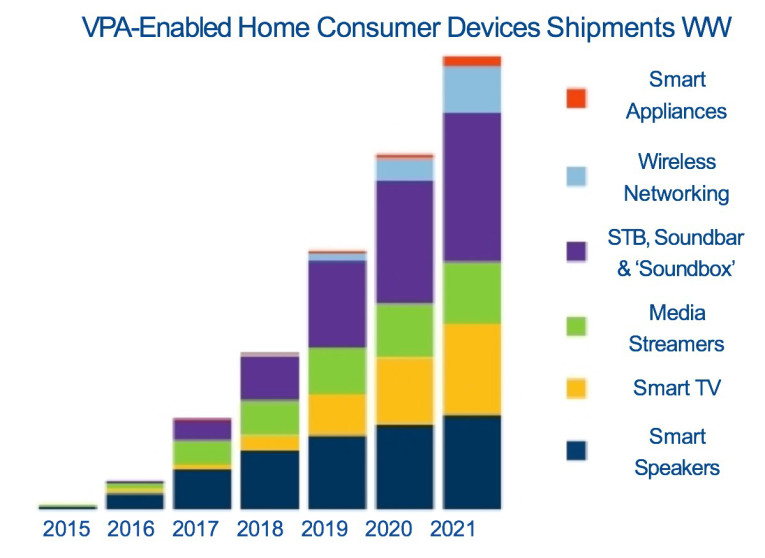
In his presentation, "What’s Next for Music Streaming?," Riad Hawa, VP Global Hardware Partnerships, Deezer addressed how service providers are embracing those key technologies and market developments that are simultaneously challenging but exciting the industry. One of those key developments being precisely digital distribution and streaming. As confirmed also by other music streaming service executives speaking at the event, we are just at the beginning of that important transition for the music industry. As Riad Hawa stated, only 10% of global the population has so far used music streaming services. As confirmed also by the latest IFPI Global Music Report 2017, there is "An explosion in global music consumption supported by multiple platforms," with revenues in the "Music Streaming" segment expected to grow at a 10% rate for the next five years.
Another important aspect revealed by these latest statistics is that the diversity of music, artists, and genres, available on the streaming platforms has never been greater (the cumulative effect of labels re-releasing practically all recorded music, plus new talent), while at the same time the number of people actually paying to listen to music has never been greater. The revenues may seem smaller when compared to the golden-age of CD, but in fact the global volume of business has never been larger.
With Spotify, Apple Music, Tidal, Deezer and many other services leading the industry, there is a consensus that the next stage of global expansion will be a challenge, since it needs to reach out to the occasional and less-enthusiastic user groups. As of July 2017, Spotify - the leading music streaming service with over 140 million users - had 60 million paying subscribers worldwide, up from 30 million paying subscribers in March 2016. Apple Music also already surpassed 30 million paid subscribers. Now, the music industry needs to conquer a new profile of more generic users, which are not so emotionally engaged with technology, and much less with the traditional concept of hi-fidelity or living room stereo. That's precisely where mobile devices - smartphones but also wearables and increasingly "hearables" like true wireless earbuds - but also the increasing role of social media as distribution platforms - will be decisive.
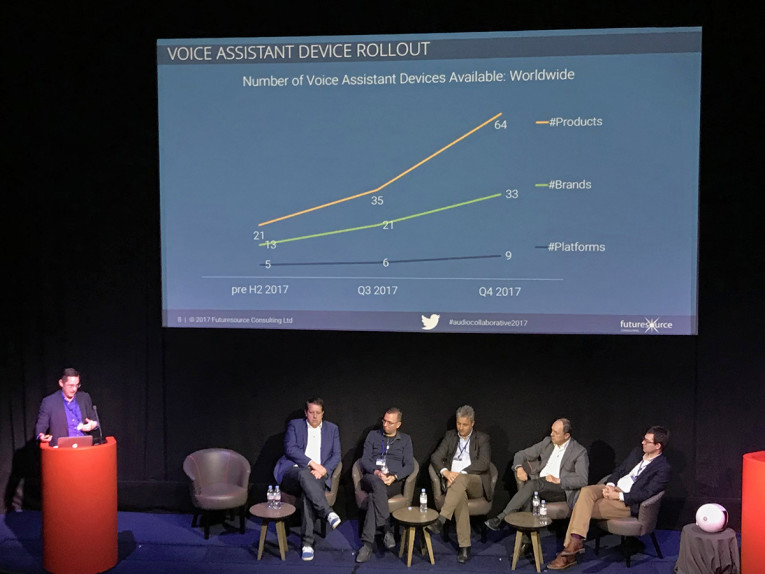
As most of the speakers in this conference have addressed, there's one new important trend that comes into play: voice. Voice was the dominant topic in Sonos' keynote address, and also for the first panel "Audio’s Role in the Smart Home." As all participants in this panel confirmed, voice assistants are positioned to be the next-generation interface. As the earlier success of products such as the Amazon Echo have proved for the home, voice assistants are fueling growth in what was an already buoyant audio market. The main use for the first generation of smart speakers is precisely to interact with music streaming services - and this is crucial for further expansion.
Services like Spotify and Tidal have been so far designed for a user profile that either already owns a music library or knows what he wants to hear and how to explore a rich music catalogue - making the extension and depth of metadata, from artists to album names, as well as cover art crucial. But the same services in mobile platforms - in particular the recently refreshed Apple Music interface - is mainly targeted at those users who prefer to rely on simple playlists, based on the users' basic preferences and/or curated directly for them. In a way, approaching the radio experience. For that kind of usage, voice interfaces are perfect and much easier, and can be directly related to simple moods and emotions, expressed in requests such as, "Alexa, play happy music."
As Adriaan Thierry detailed in his keynote, that's precisely why Sonos sees the future of voice interaction as crucial. But that's also why Sonos has a different vision, of providing its users with an open ecosystem in terms of interfaces, open to developers. Sonos wants to be free to provide the voice assistant that users prefer, and therefore wants to decouple their platform from those services, supporting already Amazon Alexa, with Google Assistant, and Apple Siri to follow in 2018. Even if that support, as confirmed by other executives, needs to be implemented on the hardware-level, also because of privacy concerns.
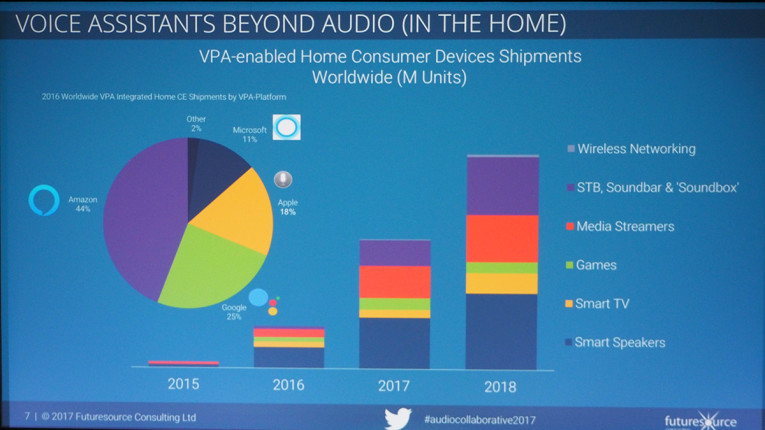
Pete Downton, Deputy CEO, 7digital, believes that voice interfaces will be critical to accelerate digital music consumption, including in connected cars, now coming to market. Most importantly, he believes that this is something that radio needs to embrace in some way. In general, all the speakers believe that music is at the forefront of the trend, but that voice will be much bigger and that the automotive applications represent an enormous opportunity for change.
Edwin van Vianen, Senior Executive Global Electronics, IBM, confirmed that his company anticipates a convergence in this domain and that the most critical aspect will be the shift in the current user interface paradigm for many new users - more than the hardware. He specifically warned about companies that are making the mistake of simply copying products to try to compete with Amazon Alexa.
Opportunities to introduce voice interfaces in other product classes, other than "smart speakers," was also discussed, even though there doesn't seem to be much consensus, for now, as to what they will be. Also, unfortunately, not much was discussed about the language barriers and the fact that development of natural language skills is not something that many companies will be able to develop themselves. Even if everyone believes that voice interoperability and not fragmenting the ecosystem is crucial.
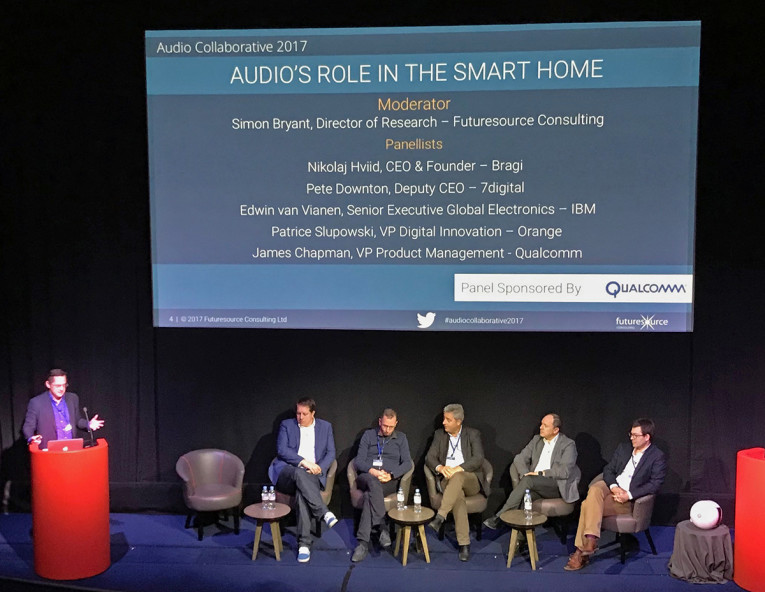
An interesting and somewhat different perspective was offered by Nikolaj Hviid, CEO & Founder of Bragi, which sees its truly wireless earbuds as just a consequence of the company's approach to create another computer interface based on voice. Hviid finds particularly amusing the fact that many companies are now copying the Bragi hearables, not understanding that they are copying "the result of success and not the success' source."
"True Wireless connectivity was a bi-product. A new type of computer was the intention. We wanted to build a computer wearable with sensors. It’s all about the computer starting to understand humans better and better," he stated. And showing how he believes that wearables/hearables will be one of the most disruptive categories in the future, Nikolaj Hviid added that "we need to keep AI on the local levels. The computer needs to understand what you want to do and keep data away from others."
James Chapman, VP Product Management, Qualcomm was another speaker on the same Smart Home panel and confirmed how the company sees the impact of voice as a pervasive user interface, and the fact that services increase the value of wearing devices. But he warned, "to be successful with voice you need access to and from consumers. Only big companies can have access and provide strong services," referring directly to the dominance of Amazon with shopping, and Google in search. "There will be a war in the ecosystem with a small number of large players." Interestingly, Chapman warned that "privacy with voice depends on bringing capabilities to the local level. Not anything needs to be on the cloud," even advising that existing services still need to build completely new security measures to expand voice interface use cases.

The panel on "The Expanding Influence of Social Media Platforms" was also extremely insightful, serving to show how complex the music industry is these days and how continuously evolving and demanding the new business models of the digital streaming age have become. Illustrating how complicated it is for all parties involved in this sector, the panel reflected on the creation and artists and ended with copyright management and inevitably the legal aspects of controlling the value-chain, all while debating the increasing role of new media platforms - of which social media companies are now a crucial part. Serving to illustrate the impact of social media on the industry, Will Hardy, responsible for Entertainment Partnerships for Music, TV, Radio & Talent on Twitter, shared how today's best selling artists have become the equivalent to "nations" in today's market, given their ability to promote a new song to 100 million fans almost instantly.
As the executives also shared, while social media creates opportunities for new artists to reach massive audiences, it also entails huge risks and challenges, including for all the traditional parties involved in management, promotion, and distribution. The panels' advice seemed to be "don't even think of doing it alone" - and I think they are absolutely right, considering the complexity for authors and creators to be paid on today's streaming media landscape. On a related note, the panel also contend about the use of social media as direct distribution platforms. YouTube is already the largest media distribution platform in the world, even if some still hesitate to call it a social network... The message was effectively that it is increasingly challenging to deal with constant changes and complexity in music services.
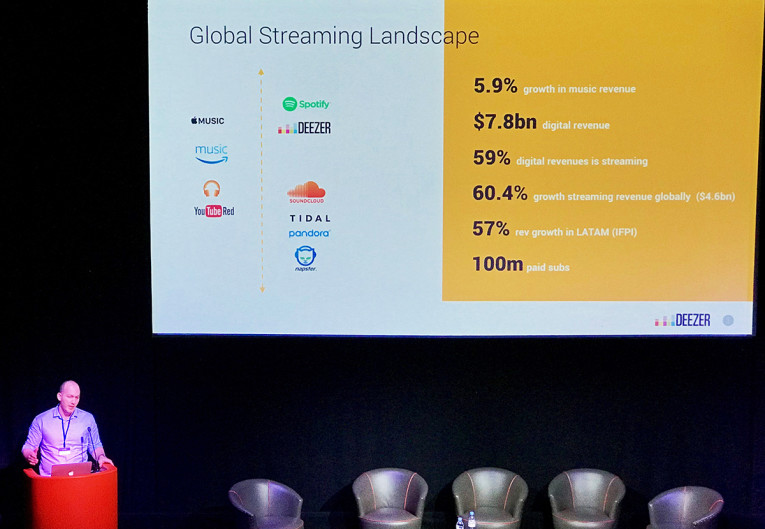
On that same note, during his presentation, "What’s Next for Music Streaming?", Riad Hawa, VP Global Hardware Partnerships, Deezer, highlighted the advantage for "pure players in music services" to expand their reach by being in all platforms, reacting faster to new technology and market developments, while companies such as Apple, or Google, or even Amazon just see music distribution as a way to reinforce their complex ecosystems, of hardware, software and services. This is something that Deezer sees as strategic, in the way they are able to establish new partnerships with the audio industry, particularly with hardware manufacturers, while at the same time driving consumers to higher quality audio experiences. The strategy, Hawa contended, lies in differentiation, quality of metadata, and creating new usage profiles, such as exploring AI, and including integration with social media platforms.
www.futuresource-consulting.com
Link to Audio Collaborative 2017 presentations





